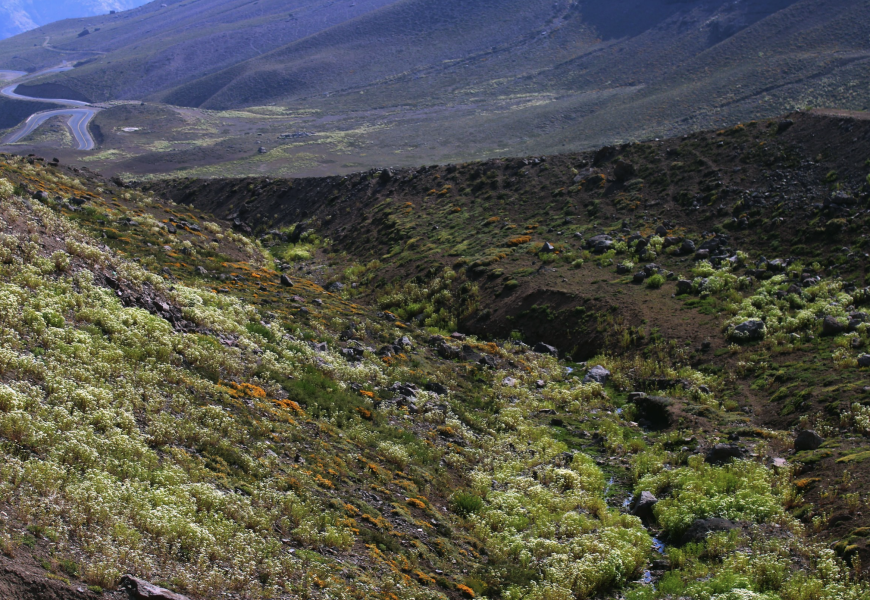International collaboration, long-term research, and awareness about the importance of mountain conservation are fundamental pillars to preserve their biodiversity, essential for our life and future climate.
By: Xuksa Kramcsak, IEB Chile: Institute of Ecology & Biodiversity / xuksa@ieb-chile.cl | Images: courtesy of Aníbal Pauchard; Lohengrin Cavieres
The majestic peaks of the Andes Mountains not only define the geographical profile of our country but also rise as a backbone that provides a wealth of ecosystem services. This peculiarity, converted into a natural bioclimatic laboratory, has caught the scientific community’s attention, especially in ecology. The variable altitudes, from the valleys close to sea level to high altitudes, generate extreme gradients that turn these mountains into fertile terrains to study ecological processes.
Doctors Aníbal Pauchard and Lohengrin Cavieres, scientists from the Institute of Ecology and Biodiversity and the University of Concepción, have spent three decades studying the ecosystems of the Malalcahuello National Reserve in the Araucanía Region and Farellones-La Parva in the Metropolitan Region. Their commitment to scientific advancement focuses on understanding the adaptation of plants to changing climatic conditions, which is crucial in the context of global climate change.
As global warming and human pressure affect higher altitude areas, the research team has observed an increase in the invasion of exotic plant species and the loss of native biodiversity. This phenomenon, documented all over the world, poses challenges for conservation. In response to this problem, Chilean scientists actively participate in the MIREN (Mountain Invasion Research Network) international network, collaborating with data from these two sites in central and southern Chile.
Through this network, they have detected a significant increase of approximately 16% in the wealth of exotic species in the last ten years. This rise in the number of alien species over a decade is surprising. According to the recently published IPBES report, it may give rise to biological invasions, one of the primary agents of biodiversity loss and, consequently, a severe danger to humanity.
Traveling through time in Malalcahuello
Using topographic climate gradients, scientists can anticipate future conditions in colder areas. This “trip through time” allows understanding the possible impact of climate change just by dropping down a few meters, offering a valuable perspective on the future of ecosystems. It is also possible to understand what will happen in colder areas closer to the poles without necessarily being there. “For example, the same gradient that you have from Santiago to Punta Arenas, you can have it on the same mountain a few hundred meters up the hill; that’s why it’s called a natural laboratory. Here, you can study climate change, understand what the future will look like by going down a few meters, and understand what that warmer ecosystem will look like,” Pauchard said.
Since the 1980s, Malalcahuello has been a practice ground for UdeC’s Forestry Faculty, as this area is the starting point of Araucaria forests towards the country’s south. It is also associated with volcanic and altitudinal gradients. Dr. Pauchard, together with academic Eduardo Peña and UdeC’s Biological Invasions Laboratory, has investigated the invasion of exotic species, identifying the advance of the Pinus contorta as an example of the vulnerability of these ecosystems.
“This site has a scenario with diverse ecosystems; it is both entertaining and different to test hypotheses in ecology, understanding the mountains as a set of slopes (laboratory) where you can study whatever you want,” said Dr. Anibal Pauchard.

Malalcahuello is home to research plots established in 2007 for MIREN. In addition, it has the Mountain Ecosystems Research Station in Malalcahuello (ESIEM) created in 2014, which strengthened the scientific presence in the area, promoting interdisciplinary collaboration between the University of Concepción, the Institute of Ecology and Biodiversity, and CONAF. The station, which has the participation of five UdeC faculties, not only promotes research at a local level but also consolidates international ties, expanding the influence of critical ecological studies.
Farellones-La Parva: Lessons on Conservation
Lohengrin Cavieres, attracted by the landscape and the specific climates of the Andes of central Chile, chose this region for his doctoral research. The Farellones-La Parva sector, with its unique climatic gradient, became a natural laboratory conducive to exploring the adaptation of plants to extreme conditions. The lower zone is dry in summer, while its upper zone is rainy. Therefore, it has very different climatic conditions that allow further questions about plant adaptation, especially in the face of drought as an environmental condition.
Within the MIREN network, Cavieres highlights the relevance of this ecosystem. The presence of invasive alien species, such as the dandelion (Taraxacum officinale) and Cerastium arvense, which reach the vegetation limits, underlines the need to understand the dynamics between native and exotic species, especially in areas crucial for water supply. “It is necessary to understand that diversity is vital for ecosystem services; mountain slopes are crucial for water supply. Having less diversity and fewer plants, the snow generates alluvium, which usually happens in Santiago due to the intervention in the mountains, as in Farellones-La Parva,” Cavieres said. “Mountains and their diversity are essential for our life as they provide water. In addition, we must reaffirm that the study and management of invasive alien species is not a xenophobic act; we are losing biodiversity, functions, and contributions of nature essential for everyone’s well-being,” says Cavieres.
The researcher warns about human intervention, such as tourism in ski resorts, mining, and livestock farming, which disperse propagules of exotic species. He underlines the importance of governance and conservation in protected areas to counteract these adverse effects and that these sites need to be made visible, especially given the level of drought that central Chile has reached as a factor of change, which will mark the fate of our climatic future. “Studying species’ tolerance to high temperatures and drought are indicators that allow us to know how sensitive native and exotic plants are at each elevation. The longer we are in a place studying this, the more likely we will be effective with the results and the subsequent management,” said Cavieres.
Chile is a country sheltered by and dependent on the Andes, and it has a great challenge and opportunity to study it from different perspectives throughout its geography. Research such as that carried out by the University of Concepción in Malalcahuello and Farellones-La Parva will allow us to face the uncertainties caused by climate change better and ensure the biodiversity and the quality of life of people directly and indirectly associated with the mountains.
Last modified: 29 de agosto de 2025






